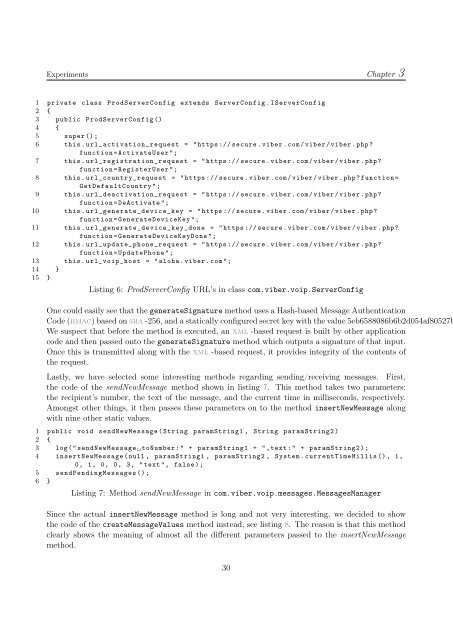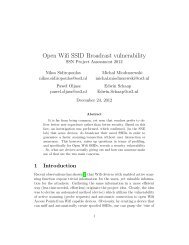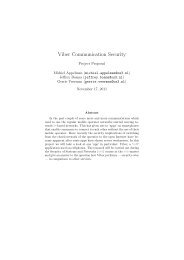Viber Communication Security - Bad Request
Viber Communication Security - Bad Request
Viber Communication Security - Bad Request
You also want an ePaper? Increase the reach of your titles
YUMPU automatically turns print PDFs into web optimized ePapers that Google loves.
Experiments Chapter 3<br />
1 private class ProdServerConfig extends ServerConfig . IServerConfig<br />
2 {<br />
3 public ProdServerConfig ()<br />
4 {<br />
5 super ();<br />
6 this . url_activation_request = " https :// secure . viber . com / viber / viber . php ?<br />
function = ActivateUser ";<br />
7 this . url_registration_request = " https :// secure . viber . com / viber / viber . php ?<br />
function = RegisterUser ";<br />
8 this . url_country_request = " https :// secure . viber . com / viber / viber . php ? function =<br />
GetDefaultCountry ";<br />
9 this . url_deactivation_request = " https :// secure . viber . com / viber / viber . php ?<br />
function = DeActivate ";<br />
10 this . url_generate_device_key = " https :// secure . viber . com / viber / viber . php ?<br />
function = GenerateDeviceKey ";<br />
11 this . url_generate_device_key_done = " https :// secure . viber . com / viber / viber . php ?<br />
function = GenerateDeviceKeyDone ";<br />
12 this . url_update_phone_request = " https :// secure . viber . com / viber / viber . php ?<br />
function = UpdatePhone ";<br />
13 this . url_voip_host = " aloha . viber . com ";<br />
14 }<br />
15 }<br />
Listing 6: ProdServerConfig URL’s in class com.viber.voip.ServerConfig<br />
One could easily see that the generateSignature method uses a Hash-based Message Authentication<br />
Code (hmac) based on sha -256, and a statically configured secret key with the value 5eb6588086b6b2d054af80527b<br />
We suspect that before the method is executed, an xml -based request is built by other application<br />
code and then passed onto the generateSignature method which outputs a signature of that input.<br />
Once this is transmitted along with the xml -based request, it provides integrity of the contents of<br />
the request.<br />
Lastly, we have selected some interesting methods regarding sending/receiving messages. First,<br />
the code of the sendNewMessage method shown in listing 7. This method takes two parameters:<br />
the recipient’s number, the text of the message, and the current time in milliseconds, respectively.<br />
Amongst other things, it then passes these parameters on to the method insertNewMessage along<br />
with nine other static values.<br />
1 public void sendNewMessage ( String paramString1 , String paramString2 )<br />
2 {<br />
3 log (" sendNewMessage ␣ toNumber :" + paramString1 + ",text :" + paramString2 );<br />
4 insertNewMessage (null , paramString1 , paramString2 , System . currentTimeMillis () , 1,<br />
0, 1, 0, 0, 3, " text ", false );<br />
5 sendPendingMessages ();<br />
6 }<br />
Listing 7: Method sendNewMessage in com.viber.voip.messages.MessagesManager<br />
Since the actual insertNewMessage method is long and not very interesting, we decided to show<br />
the code of the createMessageValues method instead, see listing 8. The reason is that this method<br />
clearly shows the meaning of almost all the different parameters passed to the insertNewMessage<br />
method.<br />
30





